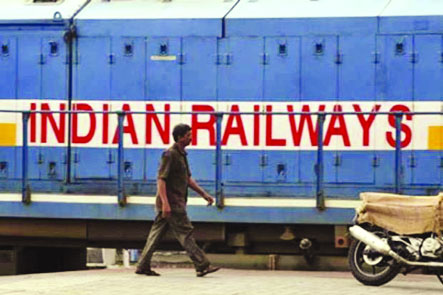Vamana, or the ‘dwarf’ container, is the latest initiative of Indian Railways’ which is expected to grow into a giant, capturing high-end traffic it lost to the road sector over the years when, in the 1980s, end-to-end running of block rakes was introduced.
Running double stack containers under 25 KV Overhead Electrification (OHE) is easier said than done. But this is exactly what Naresh Kumar, a young mechanical engineer, who left his job with the Indian Railways to try his luck in the private sector, has been able to do with his revolutionary idea of Vamana, or the ‘dwarf’ container, that makes optimum use of the envelope available under the OHE catenary.
It was in 2006, when Kumar was on deputation to the Pipavav Rail Corporation, a JV company of Indian Railways, when he conceptualised the idea of double-stack ISO containers for trains running on the non-electrified sections of Rewari-Pipavav/Mundra, which have been running almost for a decade now. Leaving his job with the railways in 2010, he set up his own company, Kalyani Cast Tech, and rest is history.
A standard 8x8x40 feet ISO container does not make use of the 4-feet additional height available up to the 25 kV OHE catenary wires, but a double-stacked dwarf container service does so, enabling almost 30 per cent savings in freight charges. Besides, the ‘dwarf’ can hold a volume of approximately 67 per cent more when compared to traditional ones. Double-stacked containers can carry a weight of 71 tonnes, as against 40 tonnes carried by an ISO container. This maximises the available envelope of moving dimensions under the catenary as well as the permissible axle load.
This could prove to be a game-changer for the Railways, winning back bulky low-density traffic, such as plastic granules, white goods, FMCG products, PVC fabric, even automobiles. So far, 90 units have been made, 180 more are on order, and the tally could reach over 2,000.
With 48 hours of transit time between Dadri-JNPT and Dadri-Pipavav-Mundra corridors, the Container Corporation of India Ltd (CONCOR) has been able to capture almost half of EXIM cargo of the ISO containers. Double stacked ISO containers between Rewari and Pipavav non-electrified section has been a runaway success, and the ‘dwarf’ could prove to be winner too, and this time right under the OHE. New ‘dwarf’ containers are lower in height by 662-mm (26 inches) and wider by 162-mm (6.3 inches) than standard ISO containers. Inside space has been maximised by adopting FRP (fibreglass reinforced plastic) flooring-only 9-mm thick, as against ISO’s 28-mm thick hardboard flooring.
The dwarf container is provided with an elongated corner castings so that the standard locking arrangement on container flat wagons could be used, even when the container is wider. Though the moving dimension permits 3,250 millimetres and 3,135 millimetres in case of double-decker coaches, the Motor Vehicle Act permits only 2,600 millimetres width on road. Hence, the ‘dwarf’ was designed with this limitation. Special dispensation by the Ministry of Road Transport and Highways for 3,250 millimetres wide dwarf containers will enable full use of the potential of the Indian Railways BG tracks.
The existing BLC flat wagons, designed for 2,438 millimetres wide ISO containers, is only 2,100 millimetres wide and part of the ISO container overhangs by 169 millimetres on either side. With 3,250 millimetres wide dwarf container, this overhang would increase to 575 millimetres on either side.
Perhaps, new wider BLCs could be designed and manufactured especially for these containers for domestic traffic; or existing ones can be modified with additional set of locks that can be fit to carry both ISO as well as dwarf domestic containers. The first consignment of polypropylene granules in 82 double-stacked containers was moved from Reliance Industries’ (RIL) own siding in Kanalus near Rajkot in Gujarat to Rewari in Haryana, earning the Railways Rs 31.4 lakh for the round trip. The second train carrying 90 dwarf containers left on August 14 from RIL’s siding near Jamnagar and reached its siding near Ludhiana in three days. This ‘green’ initiative also helps to keep thousands of trucks spewing noxious fumes off the road.
Additional routes have already been cleared for running these double-stack containers. The Jamnagar-Pune-Bangalore route via Jalgaon-Manmad-Daund-Guntakal has immense potential for freight from RIL and other auto and FMCG units located in Gujarat destined to southern States. ‘Dwarf’ offers fast, cheap and timely deliveries, which could bring about a paradigm shift from road to rail in not distant a future.
(The writer is a former Member, Railway Board)








 OpinionExpress.In
OpinionExpress.In















Comments (0)